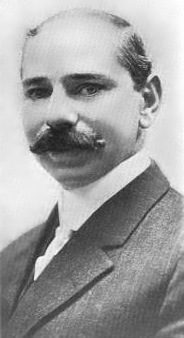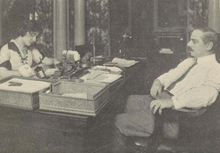Marcus Loew
| Marcus Loew | |
|---|---|
 | |
| Born |
May 7, 1870 New York City |
| Died |
September 5, 1927 (aged 57) New York City |
Marcus Loew (May 7, 1870 – September 5, 1927) was an American business magnate and a pioneer of the motion picture industry who formed Loew's Theatres and the Metro-Goldwyn-Mayer film studio (MGM).
Life and career
Loew was born in New York City, into a poor Jewish family, who had emigrated to New York City a few years previously from Austria and Germany.[1] He was forced by circumstances to work at a very young age and had little formal education. Nevertheless, beginning with a small investment from money saved from menial jobs, he bought into the penny arcade business. Shortly after, in partnership with Adolph Zukor and others, Loew acquired a nickelodeon and over time he turned Loew's Theatres into a leading chain of vaudeville and movie theaters in the United States.
By 1905, Marcus Loew was on his own and his success eventually necessitated that he secure a steady flow of product for his theaters. In 1904, he founded the People's Vaudeville Company, a theater chain which showcased one-reel films as well as live variety shows. In 1910, the company had considerably expanded and was renamed Loew's Consolidated Enterprises. His associates included Adolph Zukor, Joseph Schenck, and Nicholas Schenck. ,

By 1913, Loew operated a large number theaters in New York City including the American Music Hall, Avenue A Theatre, Avenue B Theatre, Broadway Theatre (41st St.), Circle Theatre, and the Columbia Theatre in Brooklyn. Other Loew-operated theaters were the Delancey St. Theatre, Greeley Sq. Theatre, Herald Square Theatre, Liberty Theatre, Brooklyn, Lincoln Sq. Theatre, National Theatre (149th St.), Plaza Theatre, 7th Ave. Theatre (124th St.), Shubert Theatre, Brooklyn, and the Yorkville Theatre.[2] Outside of New York, he managed the Columbia Theatre (Washington, D.C.)[3][4] Columbia Theatre (Boston) and the Metropolitan Opera House (Philadelphia).[2]
Loew found himself faced with a serious dilemma: his merged companies lacked a central managerial command structure. Loew preferred to remain in New York overseeing the growing chain of Loew's Theatres. Film production had been gravitating toward southern California since 1913. By 1917 he oversaw a number of enterprises: Borough Theatre Co., Empress Amusement Corp., Fort George Amusement Co., Glendive Amusement Corp., Greeley Square Amusement Co., Loew's Consolidated Enterprise, Loew's Theatrical Enterprises, Mascot Amusement Co., Natonia Amusement Co., People's Vaudeville Co.[5] In 1919, Loew reorganized the company under the name Loew's, Inc.[6]
In 1920, Loew purchased Metro Pictures Corporation. A few years later, he acquired a controlling interest in the financially troubled Goldwyn Picture Corporation which at that point was controlled by theater impresario Lee Shubert. Goldwyn Pictures owned the "Leo the Lion" trademark and studio property in Culver City, California. But without its founder Samuel Goldwyn, the Goldwyn studio lacked strong management. With Loew's vice president Nicholas Schenck needed in New York City to help manage the large East Coast movie theater operations, Loew had to find a qualified executive to take charge of this new Los Angeles entity.
Loew recalled meeting a film producer named Louis B. Mayer who had been operating a successful, if modest, studio in east Los Angeles. Mayer had been making low budget melodramas for a number of years, marketing them primarily to women. Since he rented most of his equipment and hired most of his stars on a per-picture basis, Loew wasn't after Mayer's brick and mortar business; he wanted Mayer and his Chief of Production, the former Universal Pictures executive, Irving Thalberg. Nicholas Schenck was dispatched to finalize the deal that ultimately resulted in the formation of Metro-Goldwyn Pictures in April 1924 with Mayer as the studio head and Thalberg chief of production.
Mayer's company folded into Metro Goldwyn with two notable additions: Mayer Pictures' contracts with key directors such as Fred Niblo and John M. Stahl, and up-and-coming actress Norma Shearer, later married to Thalberg. Mayer would eventually be rewarded by having his name added to the company. Loews Inc. would act as MGM's financier and retain controlling interest for decades.
While immediately successful, Loew didn't live to see the powerhouse that MGM was to become. He died three years later in 1927 of a heart attack at the age of 57 in Glen Cove, New York. He was interred in the Maimonides Cemetery in Brooklyn.[7]
For his very significant contribution to the development of the motion picture industry, Marcus Loew has a star on the Hollywood Walk of Fame at 1617 Vine Street. To this day, the Loew name is synonymous with movie theaters.[8]
Personal life
His son Arthur Loew, married Mildred Zukor, daughter of Adolph Zukor.[9]
References
- ↑ Caso, Frank. "Marcus Loew." In Immigrant Entrepreneurship: German-American Business Biographies, 1720 to the Present, vol. 4, edited by Jeffrey Fear. German Historical Institute. Last modified January 28, 2014.
- 1 2 Cahn-Leighton Theatrical Guide, 1913-1914
- ↑ Robert K. Headley - Motion Picture Exhibition in Washington, D.C. 1999 1476608512 p250 "... as he began to expand his movie empire. In October 1919, Loew and Walter Brownley of Washington purchased the Columbia and two buildings on 12th Street for half a million dollars. The Columbia was one of the big moneymakers among ..."
- ↑ http://cinematreasures.org/theaters/7369
- ↑ Directory of directors in the city of New York, 1917-1918
- ↑ Poor's and Moody's manual, 1921
- ↑ Marcus Loew at Find a Grave
- ↑ Robert Sobel, The Entrepreneurs: Explorations Within the American Business Tradition (Weybright & Talley 1974), luca 7, Marcus Loew: An Artist in Spite of Himself ISBN 0-679-40064-8.
- ↑ Ingham, John N. (1983). Biographical Dictionary of American Business Leaders, Volume 4. Greenwood. p. 1702. ISBN 978-0313239106.
Further reading
- Robert Sobel, The Entrepreneurs: Explorations Within the American Business Tradition (Weybright & Talley, 1974), chapter 7, "Marcus Loew: An Artist in Spite of Himself" ISBN 0-679-40064-8
External links
| Wikimedia Commons has media related to Marcus Loew. |